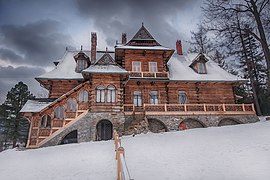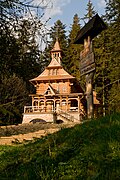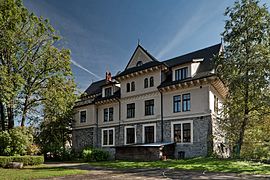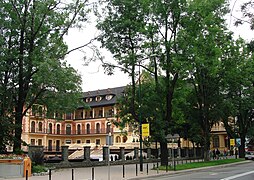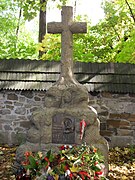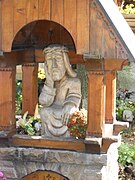Zakopane
Zakopane | ||
|---|---|---|
 View of Zakopane from Butorowy Wierch | ||
|
Car plates KTT | | |
| Website | www | |
Zakopane (Podhale Goral: Zokopane)[2] is a town in the south of Poland, in the southern part of the Podhale region at the foot of the Tatra Mountains. From 1975 to 1998, it was part of Nowy Sącz Voivodeship; since 1999, it has been part of Lesser Poland Voivodeship. As of 2017[update] its population was 27,266.[1] Zakopane is a centre of Goral culture and is often referred to as "the winter capital of Poland". It is a popular destination for mountaineering, skiing, and tourism.[3]
Zakopane lies near Poland's border with
History
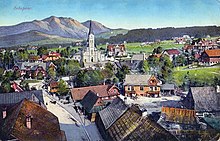
The earliest documents mentioning Zakopane date to the 17th century, describing a glade called Zakopisko. In 1676, it was a village of 43 inhabitants. In 1818, Zakopane was a small town that was still being developed. There were only 340 homes that held 445 families. The population of Zakopane at that time was 1,805: 934 women and 871 men.[4] The first church was built in 1847, by Józef Stolarczyk.[4]
Zakopane became a center for the region's
The ski jump on Wielka Krokiew was opened in 1925. The cable car to Kasprowy Wierch was completed in 1936. The funicular connected Zakopane and the top of Gubałówka in 1938.
Because of Zakopane's popular ski mountains, the town gained popularity which made the number of tourists increase to about 60,000 people by 1930.[4]
During the joint German-Soviet
From 1942 to 1943, 1,000 prisoners from the German Kraków-Płaszów concentration camp were set to work in a stone quarry.[7] In 1944, during the Warsaw Uprising, the Germans deported thousands of Varsovians from the Dulag 121 camp in Pruszków, where they were initially imprisoned, to Zakopane.[8] Those Poles were mainly old people, ill people and women with children.[8] In mid-October 1944, there were 3,800 registered Poles, who were expelled from Warsaw, and probably another 3,800 unregistered expellees.[8] In January 1945, the Germans retreated from Zakopane and the German occupation ended.
Immediately after the war, a children's Home for
Climate
Zakopane has a humid continental climate (Köppen climate classification: Dfb),[10][11] with the main factor behind its relative coldness compared to the rest of Poland is its altitude. In general, the temperature tends to fall with altitude, therefore Zakopane is almost 3 °C (5.4 °F) colder than northern Kraków, which is more than 600 m (2,000 ft) lower than Zakopane. With higher altitudes, the climate gets even colder, therefore, on the top of Kasprowy Wierch (1,987 m (6,519 ft) above sea level), the climate is tundra-like (Köppen: ET). The tree line is located at about 1,500 m (4,900 ft) above sea level in the Tatra Mountains.
Winters are typically frosty but are relatively sunny for Poland - in fact, Zakopane receives among the most sun in winter in the country.[12] Snow is normally abundant, particularly in the higher altitudes, which makes Zakopane among the most popular ski resorts in Poland. Summers are cool to warm but rarely get hot.
The defining feature of the local climate is the location on the northern slope of the Tatra mountains. Zakopane receives significantly more precipitation than cities on the lowlands to the north of the
Extreme temperatures range from −34.1 °C (−29.4 °F) on February 1, 1956 up to 32.8 °C (91.0 °F) on August 8, 2013;[13][14] the record cold daily maximum is −19.6 °C (−3.3 °F), set on February 1, 1956,[14][15] while, conversely, the record warm daily minimum is 23.4 °C (74.1 °F) on August 29, 1992.[16][17]
| Climate data for Zakopane, 49°17′38″N 19°57′37″E / 49.29389°N 19.96028°E (855 m (2,805 ft) asl, 1991–2020 normals, extremes 1951–present) | |||||||||||||
|---|---|---|---|---|---|---|---|---|---|---|---|---|---|
| Month | Jan | Feb | Mar | Apr | May | Jun | Jul | Aug | Sep | Oct | Nov | Dec | Year |
| Record high °C (°F) | 14.9 (58.8) |
17.6 (63.7) |
20.3 (68.5) |
25.5 (77.9) |
27.3 (81.1) |
31.4 (88.5) |
32.5 (90.5) |
32.8 (91.0) |
30.7 (87.3) |
26.3 (79.3) |
20.6 (69.1) |
18.4 (65.1) |
32.8 (91.0) |
| Mean maximum °C (°F) | 9.9 (49.8) |
11.0 (51.8) |
14.3 (57.7) |
20.3 (68.5) |
23.7 (74.7) |
27.4 (81.3) |
28.5 (83.3) |
28.1 (82.6) |
23.9 (75.0) |
20.8 (69.4) |
15.7 (60.3) |
10.2 (50.4) |
29.6 (85.3) |
| Mean daily maximum °C (°F) | 1.1 (34.0) |
2.0 (35.6) |
5.4 (41.7) |
11.3 (52.3) |
16.0 (60.8) |
19.5 (67.1) |
21.2 (70.2) |
21.3 (70.3) |
16.3 (61.3) |
11.8 (53.2) |
6.6 (43.9) |
1.8 (35.2) |
11.2 (52.2) |
| Daily mean °C (°F) | −3.3 (26.1) |
−2.4 (27.7) |
0.6 (33.1) |
6.0 (42.8) |
10.7 (51.3) |
14.2 (57.6) |
15.8 (60.4) |
15.6 (60.1) |
10.9 (51.6) |
6.5 (43.7) |
2.1 (35.8) |
−2.3 (27.9) |
6.2 (43.2) |
| Mean daily minimum °C (°F) | −7.0 (19.4) |
−6.3 (20.7) |
−3.5 (25.7) |
1.2 (34.2) |
5.7 (42.3) |
9.3 (48.7) |
10.8 (51.4) |
10.5 (50.9) |
6.5 (43.7) |
2.3 (36.1) |
−1.5 (29.3) |
−5.8 (21.6) |
1.9 (35.4) |
| Mean minimum °C (°F) | −17.6 (0.3) |
−15.9 (3.4) |
−12.3 (9.9) |
−6.2 (20.8) |
−0.9 (30.4) |
3.8 (38.8) |
5.4 (41.7) |
4.9 (40.8) |
0.5 (32.9) |
−5.1 (22.8) |
−10.6 (12.9) |
−15.7 (3.7) |
−19.9 (−3.8) |
| Record low °C (°F) | −29.8 (−21.6) |
−34.1 (−29.4) |
−23.8 (−10.8) |
−12.0 (10.4) |
−6.1 (21.0) |
−1.6 (29.1) |
0.9 (33.6) |
0.2 (32.4) |
−4.9 (23.2) |
−10.7 (12.7) |
−19.6 (−3.3) |
−25.5 (−13.9) |
−34.1 (−29.4) |
| Average precipitation mm (inches) | 46.6 (1.83) |
51.3 (2.02) |
61.4 (2.42) |
81.2 (3.20) |
141.5 (5.57) |
149.4 (5.88) |
191.6 (7.54) |
125.3 (4.93) |
111.0 (4.37) |
80.8 (3.18) |
59.7 (2.35) |
45.1 (1.78) |
1,145 (45.08) |
| Average extreme snow depth cm (inches) | 62.0 (24.4) |
90.5 (35.6) |
97.9 (38.5) |
71.2 (28.0) |
13.4 (5.3) |
3.3 (1.3) |
0.1 (0.0) |
0.4 (0.2) |
5.2 (2.0) |
13.7 (5.4) |
23.3 (9.2) |
37.9 (14.9) |
97.9 (38.5) |
| Average precipitation days (≥ 0.1 mm) | 17.43 | 16.27 | 17.23 | 15.70 | 18.70 | 18.37 | 18.43 | 14.77 | 14.17 | 14.90 | 15.63 | 16.53 | 198.13 |
| Average snowy days (≥ 0 cm) | 29.9 | 28.0 | 30.1 | 25.8 | 6.6 | 1.1 | 0.0 | 0.1 | 2.4 | 10.1 | 16.9 | 28.2 | 179.2 |
| Average relative humidity (%)
|
81.1 | 78.5 | 75.0 | 71.1 | 74.4 | 76.1 | 76.7 | 77.4 | 81.6 | 81.7 | 82.9 | 83.5 | 78.3 |
| Mean monthly sunshine hours | 69.1 | 81.2 | 118.2 | 162.5 | 179.6 | 178.3 | 197.1 | 193.4 | 128.4 | 113.8 | 75.6 | 55.6 | 1,552.8 |
| Average ultraviolet index | 2 | 1 | 2 | 3 | 3 | 5 | 5 | 4 | 3 | 2 | 2 | 1 | 3 |
| Source 1: Institute of Meteorology and Water Management[18][19][20][21][22][23][24][25] | |||||||||||||
| Source 2: Meteomodel.pl (records, relative humidity 1991–2020),[26][27][28] Weather Atlas (UV)[29] | |||||||||||||
| Climate data for Kasprowy Wierch, 49°13′57″N 19°58′55″E / 49.23250°N 19.98194°E (1,987 m (6,519 ft) asl, 1991–2020 normals, extremes 1951–present) | |||||||||||||
|---|---|---|---|---|---|---|---|---|---|---|---|---|---|
| Month | Jan | Feb | Mar | Apr | May | Jun | Jul | Aug | Sep | Oct | Nov | Dec | Year |
| Record high °C (°F) | 7.2 (45.0) |
9.9 (49.8) |
9.4 (48.9) |
14.2 (57.6) |
18.7 (65.7) |
22.6 (72.7) |
23.4 (74.1) |
22.5 (72.5) |
19.8 (67.6) |
16.9 (62.4) |
13.9 (57.0) |
8.8 (47.8) |
23.4 (74.1) |
| Mean maximum °C (°F) | 3.1 (37.6) |
2.6 (36.7) |
4.1 (39.4) |
8.2 (46.8) |
13.4 (56.1) |
17.9 (64.2) |
19.1 (66.4) |
18.7 (65.7) |
14.4 (57.9) |
11.9 (53.4) |
7.5 (45.5) |
4.6 (40.3) |
20.3 (68.5) |
| Mean daily maximum °C (°F) | −4.6 (23.7) |
−5.0 (23.0) |
−3.3 (26.1) |
1.2 (34.2) |
6.0 (42.8) |
10.1 (50.2) |
12.1 (53.8) |
12.3 (54.1) |
7.5 (45.5) |
3.9 (39.0) |
0.0 (32.0) |
−3.5 (25.7) |
3.1 (37.6) |
| Daily mean °C (°F) | −7.4 (18.7) |
−7.8 (18.0) |
−6.1 (21.0) |
−1.6 (29.1) |
3.0 (37.4) |
6.7 (44.1) |
8.6 (47.5) |
8.9 (48.0) |
4.6 (40.3) |
1.2 (34.2) |
−2.6 (27.3) |
−6.1 (21.0) |
0.1 (32.2) |
| Mean daily minimum °C (°F) | −10.1 (13.8) |
−10.5 (13.1) |
−8.7 (16.3) |
−4.0 (24.8) |
0.6 (33.1) |
4.1 (39.4) |
6.0 (42.8) |
6.4 (43.5) |
2.2 (36.0) |
−1.3 (29.7) |
−5.1 (22.8) |
−8.8 (16.2) |
−2.4 (27.7) |
| Mean minimum °C (°F) | −19.2 (−2.6) |
−19.4 (−2.9) |
−16.3 (2.7) |
−12.5 (9.5) |
−6.3 (20.7) |
−2.2 (28.0) |
0.0 (32.0) |
0.1 (32.2) |
−4.1 (24.6) |
−9.8 (14.4) |
−13.7 (7.3) |
−17.6 (0.3) |
−21.9 (−7.4) |
| Record low °C (°F) | −30.2 (−22.4) |
−29.1 (−20.4) |
−27.9 (−18.2) |
−18.1 (−0.6) |
−13.0 (8.6) |
−7.6 (18.3) |
−3.1 (26.4) |
−4.5 (23.9) |
−8.2 (17.2) |
−15.2 (4.6) |
−24.8 (−12.6) |
−28.0 (−18.4) |
−30.2 (−22.4) |
| Average precipitation mm (inches) | 105.1 (4.14) |
98.0 (3.86) |
112.7 (4.44) |
127.3 (5.01) |
186.0 (7.32) |
208.0 (8.19) |
248.1 (9.77) |
171.6 (6.76) |
158.5 (6.24) |
123.4 (4.86) |
117.6 (4.63) |
107.5 (4.23) |
1,763.8 (69.44) |
| Average extreme snow depth cm (inches) | 92.7 (36.5) |
130.5 (51.4) |
153.3 (60.4) |
147.9 (58.2) |
67.9 (26.7) |
14.4 (5.7) |
0.7 (0.3) |
1.2 (0.5) |
9.0 (3.5) |
15.1 (5.9) |
27.2 (10.7) |
56.1 (22.1) |
153.3 (60.4) |
| Average precipitation days (≥ 0.1 mm) | 19.83 | 18.61 | 20.17 | 18.27 | 21.00 | 20.00 | 19.57 | 16.30 | 15.57 | 16.83 | 17.83 | 19.00 | 222.97 |
| Average snowy days (≥ 0 cm) | 31 | 28.3 | 30.9 | 30.0 | 20.6 | 3.3 | 0.4 | 0.4 | 5.9 | 13.7 | 21.3 | 30.6 | 216.4 |
| Average relative humidity (%)
|
77.6 | 80.5 | 83.8 | 84.3 | 86.8 | 87.7 | 86.6 | 84.5 | 86.2 | 80.9 | 82.0 | 78.6 | 83.3 |
| Mean monthly sunshine hours | 88.9 | 91.2 | 117.1 | 154.1 | 157.5 | 153.8 | 166.5 | 179.3 | 130.8 | 121.3 | 83.8 | 80.7 | 1,524.8 |
| Source 1: Institute of Meteorology and Water Management[18][19][20][21][22][23][24][25] | |||||||||||||
| Source 2: Meteomodel.pl (records, relative humidity 1991–2020)[30][31][32] | |||||||||||||
Graphs are unavailable due to technical issues. There is more info on Phabricator and on MediaWiki.org. |
See or edit raw graph data.
Architecture

The
The most prominent examples of the style are:
- Villa Koliba - built in 1892–93 by Stanisław Witkiewicz
- Villa Oksza - built in 1894–95 by Stanisław Witkiewicz
- Villa Pod Jedlami - built in 1897 by Stanisław Witkiewicz
- Chapel in Jaszczurówka - built in 1904–07 by Stanisław Witkiewicz
- Tatra Museum - built in 1913–24 by Stanisław Witkiewicz
- Grand Hotel Stamary - built in 1903-05 by Eugeniusz Wesołowski
Other important sights in Zakopane include:
- Holy Family Church - Romanesque Revival church built in 1879–96 by Józef Pius Dziekoński
- Church of Our Lady of Częstochowa - wooden church built in 1847, located next to the Old Cemetery in Pęksowy Brzyzek
- Old Cemetery in Pęksowy Brzyzek - burial place of many artists, architects, writers, sculptors and mountaineer, among them Stanisław Witkiewicz, Kazimierz Przerwa-Tetmajer, Władysław Hasior and Sabała. There is also a cenotaph of Witkacy.
- Modernist stations of the Kasprowy Wierch cable railway (1935–36) and the Gubałówka Hill funicular (1938)
-
Villa Oksza art gallery
-
Pod Jedlami villa
-
Karol Szymanowski Museum at the Villa Atma
-
Chapel at Jaszczurówka
-
Grand Hotel Stamary
-
Romanesque RevivalChurch of the Holy Family
-
Old Cemetery in Pęksowy Brzyzek with the Church of Our Lady of Częstochowa in the background
Culture
Since the end of the 19th century Zakopane was an important place for many artists, who frequently visited, worked or lived here, especially during the Young Poland period.
Today the city hosts many museums and galleries:
- Tatra Museum
- Museum of Tatra National Park
- Museum of Zakopane Style at Villa Koliba
- Villa Oksza Art Gallery
- Karol Szymanowski Museum in Villa Atma
- Jan Kasprowicz Museum in Villa Harenda
- Kornel Makuszyński Museum
- Władysław Hasior Gallery
- Kamil Stoch Museum Galeria Kamiland
- Museum of the Armed Resistance in the former Hotel Palace
Sports
The Tatras are a popular destination among hikers, skiers, ski-tourers and climbers.
Mountaineering

There is a network of well-marked hiking trails in the Tatras and according to the national park regulations the hikers must stick to them. Most of these trails are overcrowded, especially in the summer season.
The
In summer, lightning and snow are both potential hazards for climbers, and the weather can change quickly. Thunderstorms are common in the afternoons. In winter the snow can be up to several meters deep.
Skiing
In the winter, thousands arrive in Zakopane to ski, especially around Christmas and in February. The most popular skiing areas are
Zakopane hosted the
Zakopane made unsuccessful bids to host the 2006 Winter Olympics and the 2011 and 2013 Alpine World Ski Championships.
Football
In Zakopane, there are two football clubs – one of them is KS Zakopane, which was established in 2007 as a result of the merger of ZKP Zakopane and Jutrzenka Zakopane. It currently competes in the B-class league, in the Podhale II group. Its matches are played at the facility located at Orkana Street 6.
In the 2015/2016 season, the Football Club Zakopane was reactivated. After a successful 2015/16 season, in which the ZKP players managed to secure a promotion-eligible spot in the Podhale C-class, they are now playing in the Podhale B-class league.
Tourism

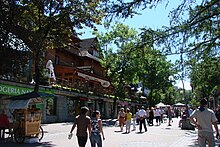
Zakopane is visited by over 2,500,000 tourists a year.[citation needed] In the winter, Zakopane's tourists are interested in winter sports activities such as skiing, snowboarding, ski jumping, snowmobiling, sleigh rides, snowshoe walks, and Ice skating.[37] During the summer, Tourists come to do activities like hiking, climbing, bike and horse ride the Tatras mountain, there are many trails in the Tatras.[37] Tourists ride quads and dirt bikes that you can rent. Swimming and boat rides on the Dunajec river are popular.[37] Many come to experience Goral culture, which is rich in its unique styles of food, speech, architecture, music, and costume. Zakopane is especially popular during the winter holidays, which are celebrated in traditional style, with dances, decorated horse-pulled sleighs called kuligs and roast lamb.
A popular tourist activity is taking a stroll along the town's most popular street: Krupówki. It is lined with stores, restaurants, carnival rides, and performers.
During the winter and summer seasons, Krupówki Street is crowded with tourists visiting the shops and restaurants.[37] In the summer, a local market along Krupówki Street offers traditional Goral apparel, leather jackets, fur coats, shoes, and purses.[37] Venders also sell foods like the famous oscypek smoked sheep cheese, fruit, vegetables, and meats. There are also many stands with Zakopane souvenirs.[37]
Zakopane is popular for its nightlife. At night there are always people walking around town checking out the different bars and dance clubs. Most of these bars and dance clubs are located on Krupowki street.[1]
Other activities include also Zakopane's Thermal Baths - a modern aquapark with outside swimming pools with thermal water.
A scene in Andrzej Wajda's film Man of Marble (Człowiek z marmuru) was filmed in Zakopane, introducing the town to a worldwide audience.
The mountain scenes from the
International relations
Zakopane participates in
 Bansko, Bulgaria
Bansko, Bulgaria San Carlos de Bariloche (Argentina)[citation needed]
San Carlos de Bariloche (Argentina)[citation needed]- Bavel (Netherlands)
 Polonezköy, Turkey
Polonezköy, Turkey Poprad, Slovakia
Poprad, Slovakia Saint-Dié-des-Vosges (France)
Saint-Dié-des-Vosges (France) Sopot, Poland
Sopot, Poland Stryi, Ukraine
Stryi, Ukraine Vysoké Tatry, Slovakia
Vysoké Tatry, Slovakia Siegen, Germany
Siegen, Germany
Notable structures
- COS Zakopane speed-skating rink
- Gubałówka Hill Funicular
- Kasprowy Wierch cable car
- Wielka Krokiew ski jumping ramp
Notable residents



- Polish Tatra Society
- Klemens Bachleda (1851-1910), Polish mountain guide and mountain rescuer, worked from Zakopane
- Stanisław Witkiewicz, (1851 – 1915) Polish painter, architect, writer and art theoretician
- Jan Kasprowicz, (1860 – 1926) poet, playwright, critic and translator; a foremost representative of Young Poland
- Mariusz Zaruski, (1867–1941) Polish Brigadier-General, a pioneer of Polish sports yachting, a climber of the Tatra Mountains, a photographer, painter, poet, a seaman, a conspirator, a social activist and teacher
- Jerzy Żuławski, (1874 – 1915) Polish literary figure, philosopher, translator, alpinist and nationalist
- Władysław Orkan, (1875 – 1930) Polish writer from the Young Poland period
- Mieczysław Karłowicz, (1876 – 1909) Polish composer, conductor, mountaineer and photographer of the Tatra Mountains
- Karol Szymanowski, (1882 – 1937) Polish composer and pianist, member of the modernist movement Young Poland; his house in Zakopane, the Villa Atma, is now a museum
- Kornel Makuszyński, (1884 – 1953) Polish writer of children's and youth literature, elected member of the Polish Academy of Literature in interwar Poland
- Stanisław Ignacy Witkiewicz (1885 – 1939), Witkacy, a painter, philosopher, playwright, novelist and photographer
- Olga Drahonowska-Małkowska, (1888 – 1979 in Zakopane), with her husband, founded scouting in Poland
- Count Edward Bernard Raczyński (1891 – 1993) Polish diplomat, writer, politician and President of Poland in exile
- Aniela Chałubińska (1902–1998), Polish geographer, geologist and university professor
- Anna Zofia Krygowska (1904–1988) Polish mathematician, known for her work in mathematics education
- Wawrzyniec Żuławski (1916 in Zakopane – 1957) Wawa Polish alpinist, educator, composer, music critic, and musicologist
- Władysław Hasior, (1928 – 1999) Polish contemporary sculptor from Podhale region, a painter and theatre set designer
- Communist Poland
- Andrzej Gąsienica-Makowski (born 1952 in Zakopane) politician, led the Nonpartisan Bloc for Support of Reforms
- Janusz Waluś (born 1953 in Zakopane) assassinated Chris Hani, General Secretary of the South African Communist Party
- Playmate of the Monthin April 1980
- Sergiusz Pinkwart, (born 1973) Polish journalist, writer, classical musician and traveler, Magellan Award winner
- Małgorzata Babiarz, (born 1984 in Zakopane) professionally known as Megitza is a singer, double bass player and composer
Sport
- Stanisław Marusarz (1913 in Zakopane – 1993 in Zakopane) Polish Nordic skiing competitor in the 1930s
- Jan Wojciech Bachleda-Curuś (1951 in Zakopane – 2009) Polish alpine skier who competed in the 1976 Winter Olympics
- Wojciech Fortuna (born 1952 in Zakopane), ski jumper, Olympic gold medallist
- Olympic gold medalist
- Oskar Kwiatkowski, (born 1996 in Zakopane), Polish snowboarder
Notable visitors
- Henryk Sienkiewicz (1846–1916)[38]
- Bolesław Prus (1847 – 1912)[39]
- Joseph Conrad (1857 – 1924)[40]
- Stefan Żeromski (1864 – 1925)[41]
- Bronisława Dłuska, (1865 – 1939) Polish physician, older sister of physicist Marie Curie[41]
- Marie Curie (1867 – 1934)[42]
- Józef Piłsudski (1867 – 1935)[40]
- Vladimir Lenin (1870 – 1924)[43]
- Alfred Döblin (1878 – 1957)[44]
- Aniela Zagórska (1881 – 1943) niece of Joseph Conrad[45]
- Rudolf Weigl (1883 – 1957)[46]
- Edward Rydz-Śmigły (1886 – 1941), Marshal of Poland, who painted some Zakopane sights
- Artur Rubinstein (1887 – 1982)[40]
- Julian Tuwim (1894 – 1953), died in Zakopane
- Krystyna Skarbek (1908 – 1952)[47]
- Stanisław Lem (1921 – 2006)[48]
- Charles III (born 1948)[49]
Gallery
-
Aerial view of Zakopane
-
Zakopane at night
-
Zakopane - view fromTatra mountainsin the background)
-
Wielka Krokiew ski jumping hill
-
Zakopane - Gubałówka Hillski run
-
Zakopane - Gubałówka Hill: a nurseryski run
-
Polana Szymoszkowa ski lift
-
KatyńMemorial in Peksów Brzyzek Cemetery
-
Traditional wooden shrine
-
Traditional oscypek cheese
-
Zakopane, mountain massif Giewont (1938)
-
Old Church in Zakopane, oil painting by Edward Rydz-Śmigły.
See also
Notes
- ^ a b GUS. "Powierzchnia i ludność w przekroju terytorialnym w 2017 r." stat.gov.pl. Retrieved 10 April 2019.
- ^ "Gwara góralska". z-ne.pl. Retrieved 13 March 2022.
- ^ "Zakopane - What To See in Poland's Winter Capital". Adventurous-Travels.com. 21 December 2015. Retrieved 18 September 2019.
- ^ a b c d e "Local history - Information about the town - Zakopane - Virtual Shtetl". www.sztetl.org.pl (in Polish). Retrieved 4 May 2017.
- ^ Wardzyńska, Maria (2009). Był rok 1939. Operacja niemieckiej policji bezpieczeństwa w Polsce. Intelligenzaktion (in Polish). Warszawa: IPN. p. 58.
- ^ "Local history | Virtual Shtetl". sztetl.org.pl. Retrieved 14 July 2022.
- ^ "Zakopane". sztetl.org.pl.
- ^ a b c "Transporty z obozu Dulag 121". Muzeum Dulag 121 (in Polish). Retrieved 6 September 2021.
- ^ The Children's Home in Zakopane, Poland: Lena Küchler's Children, Yad Vashem website
- .
- ISSN 1027-5606.
- ^ "Atlas warunków solarnych - Portal Klimat IMGW-PiB". klimat.imgw.pl. Retrieved 13 February 2022.
- ^ "Historyczne dane pomiarowe". meteomodel.pl (in Polish). 4 May 2023. Archived from the original on 4 May 2023.
- ^ a b "Historyczne dane pomiarowe". meteomodel.pl (in Polish). 4 May 2023. Archived from the original on 4 May 2023.
- ^ "Średnie i sumy miesięczne". meteomodel.pl (in Polish). 4 May 2023. Archived from the original on 4 May 2023.
- ^ "Średnie i sumy miesięczne". meteomodel.pl (in Polish). 4 May 2023. Archived from the original on 4 May 2023.
- ^ "Historyczne dane pomiarowe". meteomodel.pl (in Polish). 4 May 2023. Archived from the original on 4 May 2023.
- ^ a b "Średnia dobowa temperatura powietrza". Normy klimatyczne 1991-2020 (in Polish). Institute of Meteorology and Water Management. Archived from the original on 3 December 2021. Retrieved 5 February 2022.
- ^ a b "Średnia minimalna temperatura powietrza". Normy klimatyczne 1991-2020 (in Polish). Institute of Meteorology and Water Management. Archived from the original on 15 January 2022. Retrieved 5 February 2022.
- ^ a b "Średnia maksymalna temperatura powietrza". Normy klimatyczne 1991-2020 (in Polish). Institute of Meteorology and Water Management. Archived from the original on 15 January 2022. Retrieved 5 February 2022.
- ^ a b "Miesięczna suma opadu". Normy klimatyczne 1991-2020 (in Polish). Institute of Meteorology and Water Management. Archived from the original on 9 January 2022. Retrieved 5 February 2022.
- ^ a b "Liczba dni z opadem >= 0,1 mm". Normy klimatyczne 1991-2020 (in Polish). Institute of Meteorology and Water Management. Archived from the original on 15 January 2022. Retrieved 5 February 2022.
- ^ a b "Średnia grubość pokrywy śnieżnej". Normy klimatyczne 1991-2020 (in Polish). Institute of Meteorology and Water Management. Archived from the original on 15 January 2022. Retrieved 5 February 2022.
- ^ a b "Liczba dni z pokrywą śnieżna > 0 cm". Normy klimatyczne 1991-2020 (in Polish). Institute of Meteorology and Water Management. Archived from the original on 21 January 2022. Retrieved 5 February 2022.
- ^ a b "Średnia suma usłonecznienia (h)". Normy klimatyczne 1991-2020 (in Polish). Institute of Meteorology and Water Management. Archived from the original on 15 January 2022. Retrieved 5 February 2022.
- ^ "Zakopane Absolutna temperatura maksymalna" (in Polish). Meteomodel.pl. Retrieved 5 February 2022.
- ^ "Zakopane Absolutna temperatura minimalna" (in Polish). Meteomodel.pl. Retrieved 5 February 2022.
- ^ "Zakopane Średnia wilgotność" (in Polish). Meteomodel.pl. Retrieved 5 February 2022.
- ^ "Zakopane, Poland – Detailed climate information and monthly weather forecast". Weather Atlas. Retrieved 3 August 2022.
- ^ "Zakopane Absolutna temperatura maksymalna" (in Polish). Meteomodel.pl. Retrieved 5 February 2022.
- ^ "Zakopane Absolutna temperatura minimalna" (in Polish). Meteomodel.pl. Retrieved 5 February 2022.
- ^ "Zakopane Średnia wilgotność" (in Polish). Meteomodel.pl. Retrieved 5 February 2022.
- ^ "Zakopane Style Museum Zakopane | Poland". Zakopane Life. Retrieved 3 June 2011.
- ^ "The Tatra Museum - The Museum of the Zakopane Style". Muzeumtatrzanskie.com.pl. Retrieved 3 June 2011.
- ^ "Seattle Times - Scenic Zakopane". Retrieved 10 April 2019.
- ^ "History of Snowsports". www.fis-ski.com. Retrieved 5 November 2023.
- ^ a b c d e f altius. "Things to do in Zakopane and Tatra Mountains". www.discoverzakopane.com. Retrieved 4 May 2017.
- ISBN 978-83-240-4543-3, p. 327.
- ^ Krystyna Tokarzówna and Stanisław Fita, Bolesław Prus, 1847–1912: Kalendarz życia i twórczości (Bolesław Prus, 1847–1912: A Calendar of His Life and Work), edited by Zygmunt Szweykowski, Warsaw, Państwowy Instytut Wydawniczy, 1969, pp. 232, 235, et passim.
- ^ ISBN 1-57113-347-X, pp. 458–63.
- ^ ISBN 1-57113-347-X, pp. 463–64.
- ^ Mateusiak, Tomasz (9 March 2011). "Zakopane: Maria Skłodowska Cure kochała Podhale". zakopane.naszemiasto.pl. Retrieved 10 April 2019.
- ^ "Lenin faktycznie trafił do Zakopanego. "Bose baby (...) zupełnie jak w Rosji!"". Onet Kultura (in Polish). 4 February 2023. Retrieved 16 January 2024.
- OCLC 21950967.
- ISBN 1-57113-347-X, p. 463.
- University of Wisconsin, Madison, WI 53705, US.
- Christine Granville, G.M., O.B.E., Croix de Guerre, with a Foreword by Francis Cammaerts, D.S.O., Légion d'Honneur, Croix de Guerre, U.S. Medal of Freedom, London, Hamish Hamilton, 1975, p. 24.
- ^ "Stanisław Lem odwiedzający Tatry i Zakopane". literackifestiwal.zakopane.eu. Retrieved 16 January 2024.
- ^ Photo of HRH The Prince of Wales Thursday 13 June 2002, walking "around the lake Morskie Oko during a walk at Tatras National Park on the final stage of his tour of Poland"
Bibliography
- Stanisław Kasztelowicz and Stanisław Eile, Stefan Żeromski: kalendarz życia i twórczości (Stefan Żeromski: A Calendar of His Life and Work), Kraków, Wydawnictwo Literackie, 1961.
- ISBN 1-57113-347-X.
- Krystyna Tokarzówna and Stanisław Fita, Bolesław Prus, 1847–1912: Kalendarz życia i twórczości (Bolesław Prus, 1847–1912: A Calendar of His Life and Work), edited by Zygmunt Szweykowski, Warsaw, Państwowy Instytut Wydawniczy, 1969.



